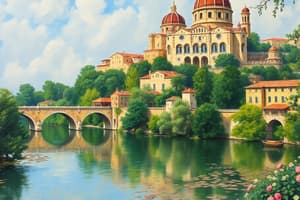Podcast
Questions and Answers
What is the primary goal of sustainable cultural tourism?
What is the primary goal of sustainable cultural tourism?
- Maximizing profits for tourism companies
- Creating social, environmental, and economic benefits for local communities (correct)
- Promoting only tangible cultural heritage
- Preserving cultural heritage without community involvement
Sustainable cultural tourism development focuses solely on economic growth without considering cultural heritage.
Sustainable cultural tourism development focuses solely on economic growth without considering cultural heritage.
False (B)
What should be the relationship between cultural heritage and local communities in sustainable cultural tourism?
What should be the relationship between cultural heritage and local communities in sustainable cultural tourism?
Integrated and beneficial for all stakeholders
Sustainable cultural tourism aims to achieve both tangible and __________ cultural heritage conservation.
Sustainable cultural tourism aims to achieve both tangible and __________ cultural heritage conservation.
Match the concepts with their definitions in sustainable cultural tourism:
Match the concepts with their definitions in sustainable cultural tourism:
Which type of cultural tourist is classified as having a deep experience with purposeful motives?
Which type of cultural tourist is classified as having a deep experience with purposeful motives?
Cultural tourism is primarily defined as traveling without any cultural motivations.
Cultural tourism is primarily defined as traveling without any cultural motivations.
Name one of the four elements of cultural tourism according to McKercher and Du Cros (2002).
Name one of the four elements of cultural tourism according to McKercher and Du Cros (2002).
A ________ Cultural Tourist engages in cultural tourism with little depth in their experiences.
A ________ Cultural Tourist engages in cultural tourism with little depth in their experiences.
Match the type of cultural tourist with their characteristics:
Match the type of cultural tourist with their characteristics:
Which characteristic best describes a cultural tourist?
Which characteristic best describes a cultural tourist?
Cultural tourists are only interested in visiting popular tourist attractions.
Cultural tourists are only interested in visiting popular tourist attractions.
What age groups can be included in the profile of a cultural tourist?
What age groups can be included in the profile of a cultural tourist?
Managing tourism based on __________ principles ensures long-term quality of life for local communities.
Managing tourism based on __________ principles ensures long-term quality of life for local communities.
Match the following attributes of cultural tourists with their descriptions:
Match the following attributes of cultural tourists with their descriptions:
What was a significant factor that contributed to the emergence of cultural tourism in the 1960-1970s?
What was a significant factor that contributed to the emergence of cultural tourism in the 1960-1970s?
Cultural tourism did not gain popularity until the 2000s.
Cultural tourism did not gain popularity until the 2000s.
Name three segments into which cultural tourism diversified in the 2000s.
Name three segments into which cultural tourism diversified in the 2000s.
Currently, contemporary cultural tourism involves cultural consumption, motivations, and the __________ between tourism and cultural heritage.
Currently, contemporary cultural tourism involves cultural consumption, motivations, and the __________ between tourism and cultural heritage.
Match the following decades with their significance regarding cultural tourism:
Match the following decades with their significance regarding cultural tourism:
What is a key consideration for packaging diverse cultures as a tourism product?
What is a key consideration for packaging diverse cultures as a tourism product?
Cultural festivals should only be celebrated for their economic benefits.
Cultural festivals should only be celebrated for their economic benefits.
What are two methods to preserve extravagant cultural festivals?
What are two methods to preserve extravagant cultural festivals?
To generate revenue for communities, interesting cultural infrastructures can be developed into __________ sites.
To generate revenue for communities, interesting cultural infrastructures can be developed into __________ sites.
Match the strategy with its purpose in sustainable cultural tourism:
Match the strategy with its purpose in sustainable cultural tourism:
Which of the following is NOT a key aspect of sustainable cultural tourism?
Which of the following is NOT a key aspect of sustainable cultural tourism?
The role of stakeholders is essential in promoting and managing cultural heritage.
The role of stakeholders is essential in promoting and managing cultural heritage.
What role does Information and Communication Technology (ICT) play in cultural tourism?
What role does Information and Communication Technology (ICT) play in cultural tourism?
Cultural heritage includes both tangible and __________ values.
Cultural heritage includes both tangible and __________ values.
Match the elements of sustainable cultural tourism with their descriptions:
Match the elements of sustainable cultural tourism with their descriptions:
Which of the following is NOT one of the core indicators for tourism destination management according to the WTO?
Which of the following is NOT one of the core indicators for tourism destination management according to the WTO?
Consumer satisfaction is a core indicator for managing cultural tourist destinations.
Consumer satisfaction is a core indicator for managing cultural tourist destinations.
Name a core indicator related to environmental concerns in tourism management.
Name a core indicator related to environmental concerns in tourism management.
_____ management is an essential indicator for planning sustainable tourism destinations.
_____ management is an essential indicator for planning sustainable tourism destinations.
Match the core indicators of tourism management with their descriptions:
Match the core indicators of tourism management with their descriptions:
Which scenario indicates that Host Culture dominates and stifles Guest Culture?
Which scenario indicates that Host Culture dominates and stifles Guest Culture?
A successful tourist culture requires a balance between host and guest cultures.
A successful tourist culture requires a balance between host and guest cultures.
What does the intersection of Host Culture and Guest Culture represent?
What does the intersection of Host Culture and Guest Culture represent?
In the 'Host-Guest Tourist Culture Nexus', the scenario labeled C shows how _______ undermines Tourist Culture.
In the 'Host-Guest Tourist Culture Nexus', the scenario labeled C shows how _______ undermines Tourist Culture.
What are some positive impacts associated with tourism culture?
What are some positive impacts associated with tourism culture?
Match the scenarios with their descriptions:
Match the scenarios with their descriptions:
Tourism culture is not influenced by the actions of the visitors.
Tourism culture is not influenced by the actions of the visitors.
Name one factor that contributes to more sustainable forms of tourism development.
Name one factor that contributes to more sustainable forms of tourism development.
Tourism culture may facilitate or disrupt by dynamics of tourism __________ and decline.
Tourism culture may facilitate or disrupt by dynamics of tourism __________ and decline.
Match the following terms with their descriptions of tourism culture:
Match the following terms with their descriptions of tourism culture:
Which principle emphasizes recognizing the intrinsic value of cultural heritage?
Which principle emphasizes recognizing the intrinsic value of cultural heritage?
Cultural tourism should solely focus on the needs of tourists rather than local communities.
Cultural tourism should solely focus on the needs of tourists rather than local communities.
Name one principle that ensures fairness in cultural tourism.
Name one principle that ensures fairness in cultural tourism.
Cultural tourism must be responsive to __________ and help achieve high-quality visitor experiences.
Cultural tourism must be responsive to __________ and help achieve high-quality visitor experiences.
Match the following principles of sustainable cultural tourism with their descriptions:
Match the following principles of sustainable cultural tourism with their descriptions:
Which principle refers to recognizing cultural tourism as an economically important activity?
Which principle refers to recognizing cultural tourism as an economically important activity?
Cultural tourism has no impact on local communities.
Cultural tourism has no impact on local communities.
What is a key consideration for effective management in cultural tourism?
What is a key consideration for effective management in cultural tourism?
Study Notes
Sustainable Cultural Tourism Development
- Sustainable cultural tourism aims to integrate cultural heritage and tourism activities, benefiting local communities and stakeholders in a sustainable manner.
- It emphasizes the preservation and economic growth of communities and protected areas while contributing to overall sustainable tourism development.
Classifying Cultural Tourists
- Cultural tourists are categorized based on the importance of their cultural motivations and the depth of their experience.
- McKercher (2002) defines four types of cultural tourists:
- Incidental Cultural Tourists: Primarily motivated by factors other than culture, with minimal cultural engagement.
- Casual Cultural Tourists: Have some cultural interest but engage in superficial experiences.
- Purposeful Cultural Tourists: Motivated by cultural experiences and actively participate in planning and engagement.
- Serendipitous Cultural Tourists: Seek deeper and more authentic cultural experiences, going beyond traditional tourist activities.
Cultural Tourist Profile and Sustainability
- Cultural tourists typically exhibit a high educational and cultural level, ranging from millennials to senior citizens.
- They demonstrate keen interest in local aspects like cuisine and show concern for the environment.
- Cultural tourists value authentic experiences, appreciate cultural differences, and prefer to interact with local populations.
Managing Tourism for Sustainability
- Sustainable tourism management ensures long-term well-being for local communities and high-quality experiences for visitors.
- Sustainable practices focus on preserving cultural heritage, protecting environments, and fostering economic benefits for local communities.
Global Economic Demands for Cultural Tourism
- From the 1960s to the present, cultural tourism has transitioned from a social phenomenon to a diverse market sector.
- Initially focused on historical sites, cultural tourism now encompasses a broader range of cultural activities, including lifestyles, creativity, and everyday experiences.
Sustainable Cultural Tourism Principles
- European Association of Historic Towns and Regions (EAHTR, 2006) outlines key principles:
- Climate Change Awareness: Addressing climate change through carbon emission reduction.
- Intrinsic Value Recognition: Acknowledging the inherent value of cultural heritage.
- Respect for Local Culture: Demonstrating respect for local cultures and supporting sustainable tourism approaches.
- Economic Importance: Recognizing the economic significance of cultural tourism for sustainable development.
- Heritage Preservation: Protecting and conserving cultural heritage assets.
- Local Community Needs: Addressing the needs of local communities and involving them in development.
- Justice and Fairness: Ensuring equitable benefits for local communities and long-term sustainability.
- Effective Management: Involving stakeholders (government, local groups, businesses) in managing cultural tourism.
- Responsiveness to Change: Adapting to changing needs and trends in cultural tourism.
- Impact Assessment: Assessing the impact of tourism on consumers and producers.
Challenges in Achieving Sustainable Cultural Tourism
- Definition of Cultural Heritage: Defining cultural heritage and its intangible values poses a challenge.
- **** Role of Stakeholders: Identifying the roles and responsibilities of various stakeholders in cultural heritage management is crucial.
- Role of ICT: Utilizing information and communication technology to promote cultural heritage and engage stakeholders presents opportunities and challenges.
Tourism Culture: Nexus, Characteristics, and Sustainability
- Canavan (2016) proposes the concept of "tourism culture" – a blend of host and guest cultures, shaped by interactions and tourism dynamics.
- This "Host-Guest Tourist Culture Nexus" requires balance and interplay between host and guest influences to foster a sustainable tourism culture.
Planning and Managing Cultural Tourist Destinations
- WTO (1996) highlights core indicators for managing tourism destinations effectively:
- Site protection
- Stress levels
- Use intensity
- Social impact
- Development control
- Waste management
- Planning process
- Critical ecosystems
- Consumer satisfaction
- Local satisfaction
- Tourism contribution to local economy
Studying That Suits You
Use AI to generate personalized quizzes and flashcards to suit your learning preferences.
Description
This quiz explores the principles of sustainable cultural tourism and its impact on local communities. It also categorizes different types of cultural tourists based on their motivations and levels of engagement. Test your knowledge on how cultural heritage can be integrated with tourism sustainability.




